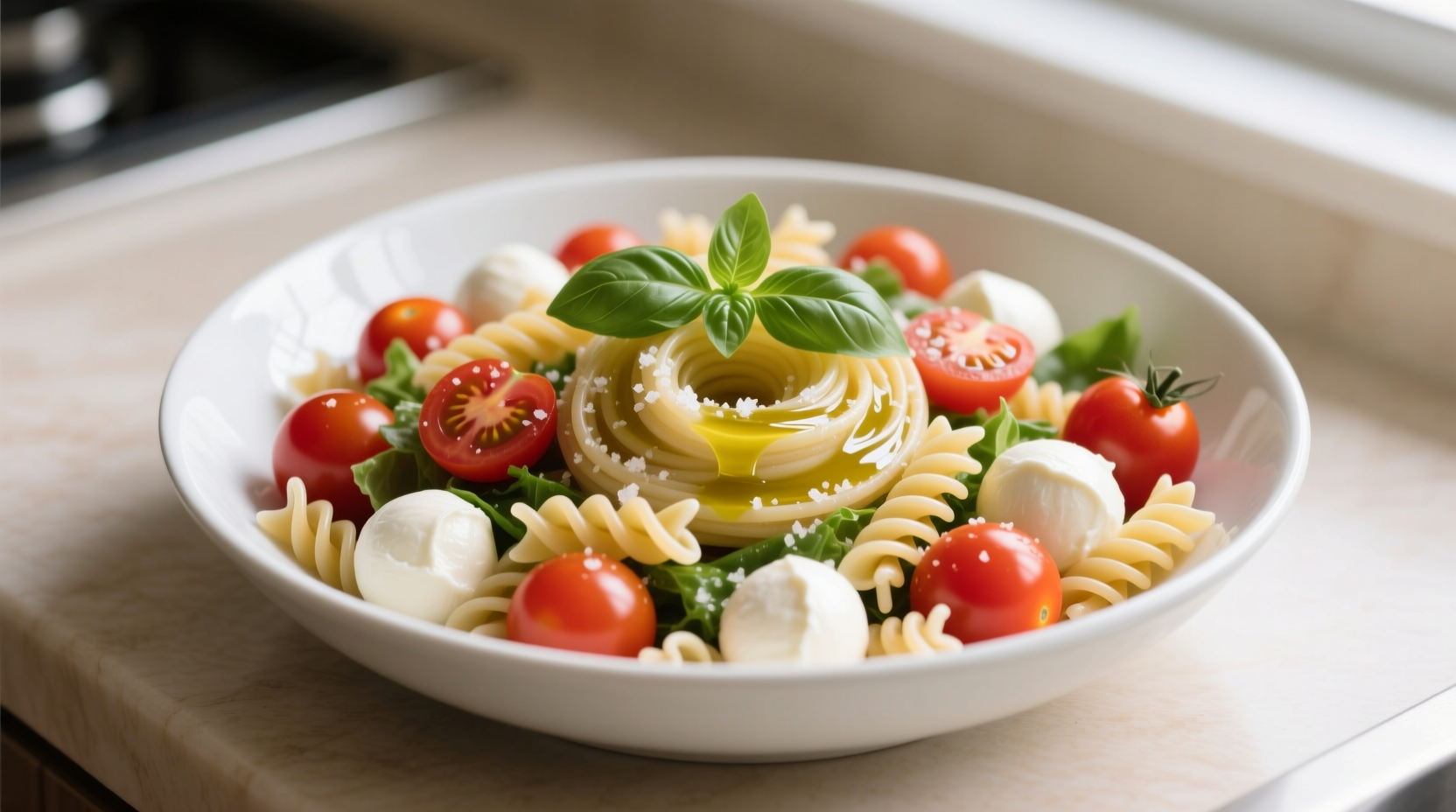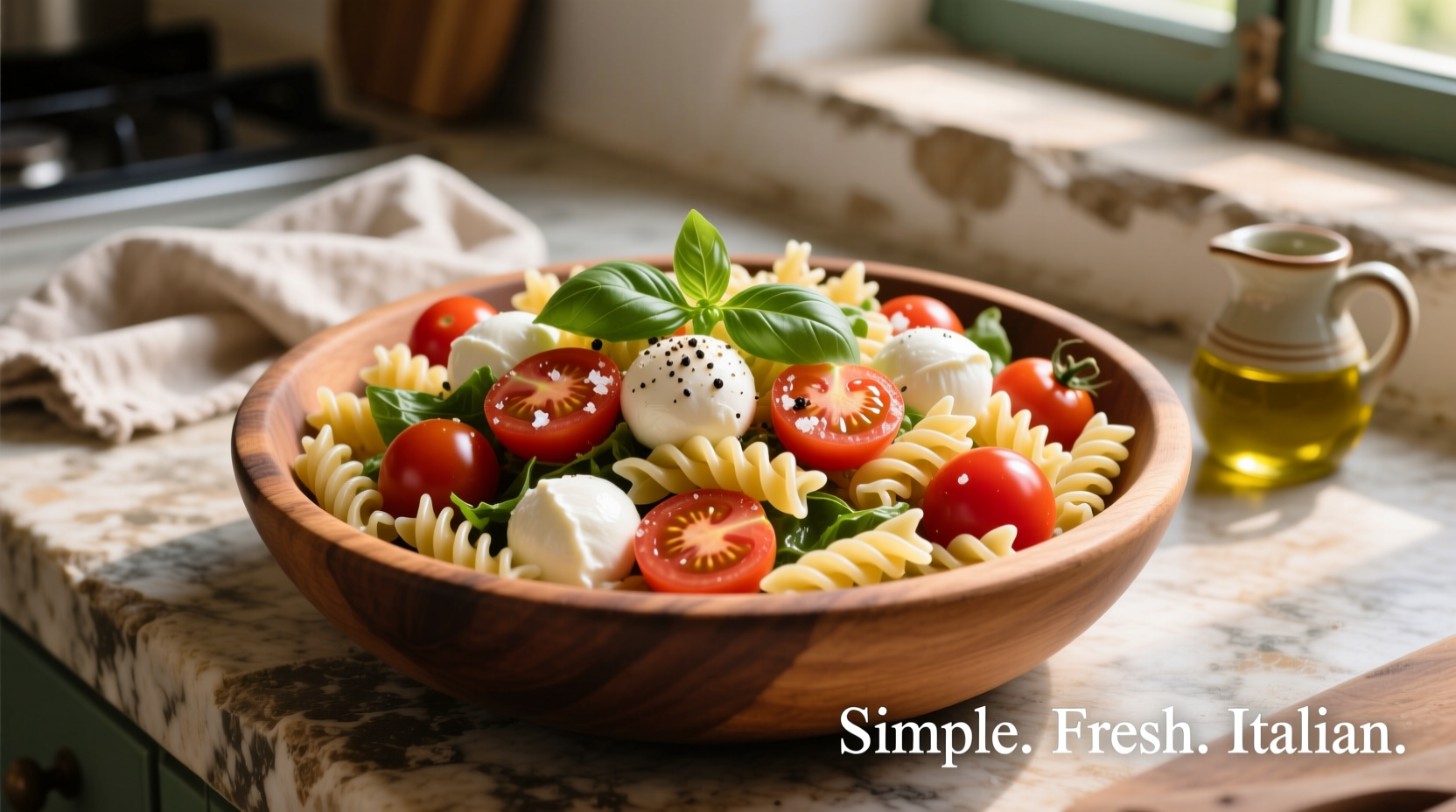Tomato mozzarella pasta salad combines ripe cherry tomatoes, fresh mozzarella pearls, and perfectly cooked pasta in a light balsamic dressing. This refreshing dish delivers Mediterranean flavors with minimal preparation time, making it ideal for summer gatherings or quick lunches.
Why This Salad Works: The Science of Flavor Harmony
The magic of tomato mozzarella pasta salad lies in the complementary flavor compounds between its key ingredients. Lycopene in tomatoes enhances the creamy texture of fresh mozzarella, while the acidity in quality balsamic vinegar cuts through the richness. Food scientists at the University of California Davis confirm that the umami compounds in ripe tomatoes (measured at peak ripeness with a Brix level of 5-6) create optimal flavor synergy with dairy proteins in fresh mozzarella.
| Ingredient | Optimal Selection | Flavor Contribution |
|---|---|---|
| Tomatoes | Variety: Sweet 100 or Sun Gold Size: Cherry or grape Ripeness: Deep red, slightly soft |
Acidity: 4.3-4.9 pH Sweetness: 5-6 Brix Umami: Glutamic acid |
| Mozzarella | Type: Fresh cow's milk pearls Texture: Springy, moist Temperature: Chilled |
Fat content: 45-50% Moisture: 52-60% Protein: Casein structure |
| Pasta | Type: Orzo or small shells Cooking: Al dente +1 minute Temperature: Cooled completely |
Starch: 75-80% Protein: 10-12% Water absorption: 150-200% |
Essential Ingredients Guide
Quality ingredients make the difference between ordinary and exceptional tomato mozzarella pasta salad. For the tomatoes, choose vine-ripened varieties harvested at peak season (June-August in most regions) when lycopene levels are highest. The USDA Agricultural Research Service confirms that properly stored fresh tomatoes maintain optimal flavor compounds for 3-5 days at room temperature.
Fresh mozzarella pearls (bocconcini) work better than shredded cheese because their higher moisture content (52-60% versus 45% in low-moisture mozzarella) creates the signature creamy texture without becoming greasy. Look for mozzarella packed in whey rather than brine for the best flavor profile.
For pasta, small shapes like orzo, ditalini, or mini shells hold the dressing best. Cook pasta al dente plus one minute to account for continued cooking during cooling. The Academy of Nutrition and Dietetics recommends rinsing pasta in cold water only when making cold salads to stop the cooking process and remove excess starch.

Step-by-Step Preparation
Pro Tip: Never dress pasta while hot. Allow pasta to cool completely (about 20 minutes) before adding dressing to prevent mushiness. This crucial step maintains ideal texture by allowing starch granules to stabilize.
- Cook 12 oz pasta according to package directions plus 1 minute
- Drain and rinse under cold water until completely cool
- Whisk together 1/4 cup extra virgin olive oil, 3 tbsp balsamic vinegar, 1 tsp Dijon mustard, 1 minced garlic clove, salt and pepper
- Toss cooled pasta with dressing while pasta is still damp
- Add 2 cups halved cherry tomatoes and 8 oz mozzarella pearls
- Gently fold in 1/4 cup torn fresh basil leaves
- Chill at least 2 hours before serving
Serving Recommendations
This versatile salad shines in multiple settings:
- Picnics & Potlucks: Layer in mason jars with dressing at bottom to prevent sogginess
- Weeknight Dinners: Serve alongside grilled chicken or fish for complete meal
- Brunch: Add hard-boiled eggs and avocado slices for protein boost
- Formal Entertaining: Present in hollowed bread bowls for elegant presentation
The Mediterranean Diet Foundation recommends including at least three vegetable colors in meals for optimal nutrient diversity. This tomato mozzarella pasta salad naturally achieves this with red tomatoes, green basil, and optional additions like yellow bell peppers or purple onions.
Storage and Make-Ahead Tips
Proper storage maintains freshness and food safety. According to USDA Food Safety guidelines, pasta salad with dairy ingredients should be stored at 40°F or below and consumed within 3-5 days. Never leave at room temperature for more than 2 hours (1 hour if above 90°F).
For best results when making ahead:
- Prepare dressing separately and combine 2 hours before serving
- Add tomatoes and mozzarella just before serving to maintain texture
- Store undressed pasta in airtight container with damp paper towel
- Revive leftovers with splash of olive oil and fresh lemon juice
Common Variations
Adapt this classic recipe to suit different dietary needs and flavor preferences:
- Protein Boost: Add 1 cup chickpeas or white beans for vegetarian protein
- Gluten-Free: Substitute quinoa or chickpea pasta (cook time varies)
- Creamier Version: Mix in 2 tbsp mascarpone cheese with dressing
- Herb Variations: Try oregano and mint instead of basil for Greek twist
Troubleshooting Guide
Solve common issues with these professional solutions:
- Soggy Pasta: Overcooked pasta or dressing added while hot - cook pasta al dente plus 1 minute and cool completely before dressing
- Watery Salad: Tomatoes releasing liquid - salt tomatoes lightly and drain excess liquid after 10 minutes
- Bland Flavor: Underseasoned - add dressing gradually and taste as you go, finishing with flaky sea salt
- Dressing Separation: Emulsify properly by whisking vinegar into oil slowly, or add 1 tsp Dijon mustard as stabilizer











 浙公网安备
33010002000092号
浙公网安备
33010002000092号 浙B2-20120091-4
浙B2-20120091-4